On a bike tour in Iran
From Isfahan to Shiraz
Iran is not the country of cycling tourists. Iran is the country of mountains, highlands, deserts, mosques, world heritages, explorers and hospitality. An Iranian bike tour needs more effort to organize than a „traditional” tour but it offers much more experiences as well. Knowing these things, perhaps we should modify the first phrase. Iran is the country of the open-minded cyclists, who are seeing the good in others and their country.
Preparations, technical details
There are international sanctions against Iran for many years, which makes the life of the tourists slightly difficult. It results – among others – that the international bank cards don't work here. But there are at least two remedies for this problem: using cash (first of all euro or US dollar) or tourist card. The latter one is in fact a bank card, which has developed for tourists.
Keep in mind that the exchange rate of the local currency is very low, so you will get millions of rials e.g. for 200 euros. Although the official currency of Iran is the rial, the prices are often given in toman. The toman is in fact a non-existing currency, which helps only to calculate the prices. The essence of the calculation is the following: One toman is 10 rials. In case of toman the locals usually don't say the thousands. So for example 5 tomans are in fact 5,000 tomans, namely, 50,000 rials.
Lots of websites, blogs and forums collect informations about buying and using tourist card. Relevant and current informations to be found for example HERE.
We must have a visa for entering Iran. It is also possible to get visa on arrival at the international airports but it is practical if you collect it in advance. In the last two years, I have obtained the Visa Authorization Code with the help of the Key2Persia, which is a partner of Caravanistan. Namely, you can receive your visa only after you get the code. The price of the visa was 50 euros and it was ready in a week. From 2019 the Iranian Ministry of Foreign Affairs uses an eVisa system and you will receive your visa on an A4 paper. It is important to know that you can't enter Iran if you visited earlier Israel. When requesting the code, you have to present a route plan as well. It is suggested to create a bold plan not to be pressed for time. In this case, you can prolong your visa once in the main tourist centres.
The easiest way to get to Tehran by air is via Istanbul. Of course, there are also international flights to other Iranian cities (for example to Isfahan or Shiraz) but they are more expensive.
The international airport of Tehran is the Imam Khomeini Airport (pronunciation: Imam Homeini), located south of the city, about 60 km from the city centre. However the national flights start from the Mehrabad Airport, which is west of the centre.
The traffic morale is quite exotic in Iran. In the last two years, I have cycled more than 2,000 km here, but I have to learn the local traffic customs yet. Cycling is not recommended on the highways of Tehran. The crossing of the roads also needs unusual skills. The most important is to behave predictable, so ride firmly, rectilinearly with unchanged speed. The average speed of the cars is quite slow in the towns, about 30 km/h. New experience for me that the car drivers respect better the red lights now than last year. It is important to note that motor cyclists often coming on the edge of the road from the opposite direction and the car drivers frequently start without using their indicator. So you have to expect that a front of a car appears suddenly before your front wheel. A negligible percentage of the motor cyclists wear a safety helmet, usually they haven't got a rear-view mirror and they don't look back before changing direction. However, it is often seen that a whole family (3-4 persons) is travelling by a motorcycle. Because the Iranian drivers consider flexible traffic laws, so the most important pledge of the accident-free traffic is the frequent communication, namely the frequent tooting.
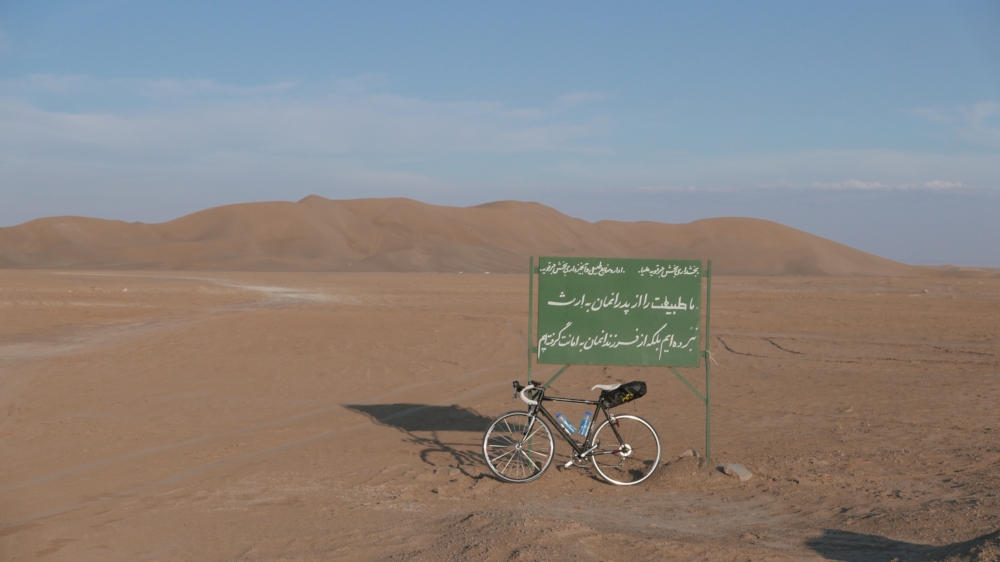
In the desert between Hassan Abad and the Khara salt lake
The drivers overtake the cyclists very carefully on the rural roads. The quality of the roads is rather good and generally there are hard shoulders along the main roads, which makes the cycling safer. But the lack of the hard shoulder – particularly at night on highways – needs increased attention. Another inconvenience can be caused by the rumble strips. Driving across these strips is relative comfortable at higher speed (about 40 km/h and above), but they strongly jolt us at lower speed.
The Iranian hospitality is world champion. The locals show a high interest in the foreigners, but they are not meddlesome. However the motor cyclists often riding next to the cyclists and communicating enthusiastically despite the lack of common vocabulary. In spite of the hospitality and the kindliness of the locals it can be important to travel securely with due precaution.
It is easy to get a puncture in Iran. Taking the last year's experiences into consideration I have used better tyres and a mini pump with manometer (in the interest of ideal air pressure) for preventing punctures. Thanks to these preparations and the Providence, I had only 3 punctures.
The weather is hot and dry in most of the country in summer. The mean daily maximum temperatures are usually above 35 oC, but they are about 46-47 oC in the southwestern part of the country. Fortunately it is more tolerable because of the low humidity, nevertheless the best time to go to Iran is spring (April or May) or autumn (September or October). Practically there is no rain during summer season, so usually even the bigger rivers also dry up at this time. Accordingly, the landscape shows different faces before and after the rainless summer.
When choosing the travel date, it is advisable to avoid the period of the Persian New Year (Nowruz) and the fasting month of Ramadan. The first-mentioned is a 13-day long celebrations, whose first day is the spring equinox. At this time lots of people set off and it is very difficult to find a room for the night. And during the Ramadan period all eating and drinking is forbidden between sunrise and sunset. Of course, this law does not apply to the passengers, but the food shops and the restaurants aren't open this period, so it is difficult and unsympathetic to eat and drink before the locals' very eyes.
The local written and unwritten rules have got lots of exotic traits, which influence the housing equipments, the obligatory dress code, the eating practices and other aspects of the life as well. Thus, for example, the men can't wear shorts and women have to hide their hair.
The Iranian bathroom differs from what is common in the Western world. The most striking difference is that most WC is squatting in Iran. And in the case of traditional meal you can eat sitting cross-legged from a tablecloth placed on the carpet.
Many international websites, such as Google and Facebook are not accessible in Iran. It is advisable to take it into account when planning the journey.
Half of the world
The starting point of my tour was Isfahan, where I arrived by bus. For this I only had to go by bike to the South Bus Terminal of Tehran. Unfortunately I was very careless so I lost my way, although I used a GPS device. Because I chose a bad method of correcting the mistake, I had to cycle more than 70 km to the bus terminal.
My flight arrived shortly after midnight (local time) in Tehran, so I was cycling towards the bus terminal already at 1 o’clock. Because of my last year’s journey I found lots of familiar streetscapes en route.
Iran is a traditional Muslim country, so Thursday and Friday is the weekend here. Because I arrived on Friday and furthermore it was night time, so the traffic was very sparse.
In the bus terminal a very enthusiastic, older man guided me. At leave-taking he told me „Guten Tag”, which means „good afternoon” in German.
In Iran you can transport bikes on the buses and on most trains. If you travel by bus, you only have to put your bike in the boot and pay for it. Although the bus tickets are very cheap, it is possible that you have to pay relatively a lot for bike transport.
Some buses operate as shared taxi, so it starts only when it is full. There are no standing passenger, the seats are very comfortable and the legroom is enough even for a two and a half meters tall passenger. Unrelated man and woman can not sit side by side. So if necessary they change the seating plan to prevent it.
Isfahan is one of the most beautiful cities in the world. It flourished in the 16th century. At that time, lots of palaces, mosques, gardens and bridges were built in the city, therefore the locals said that „Isfahan nesfe Jahan”, which means „Isfahan is half of the world”.
The most important sight of the city is the Naqsh-e Jahan Square, which is the second largest square of the world after the Tienanmen Square. This square is a real wonder and so it is on the list of world heritages of UNESCO. In Iran the famous buildings are almost always lit during the hours of darkness. It is also true for the Naqsh-e Jahan Square, so it is advisable to visit here at night as well. The most important sights of the square are the Ali Qapu Palace, the Shah Abbasi and the Sheikh Lotfollah Mosque. I visited the last two of them.

The Sheikh Lotfollah Mosque in Isfahan
During my tour I visited two times the square. The first time a young guy appeared with some children. It turned out that he is an English teacher and they came to practise the English language. This time I was the kind, anglophone tourist with whom they could practise their English. After the initial stage fright I spoke enthusiastically with my new „pupils”. As a matter of fact, they floated some words and names and from these, I created whole phrases and tried to engage them in conversation. In the end we took some common photos. That’s how I became an „English teacher” in Isfahan.
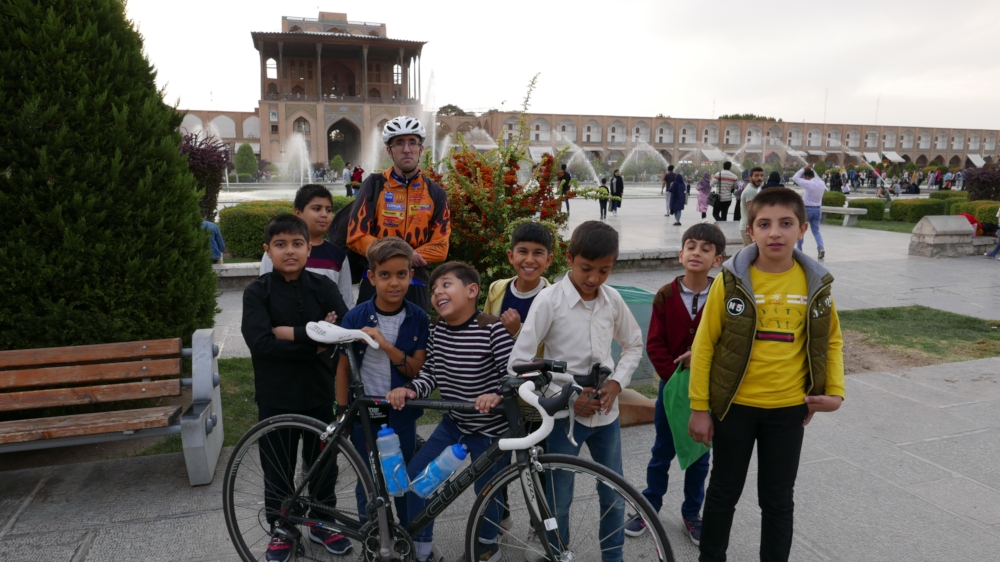
In the Naqsh-e Jahan Square - with kind pupils
In addition to the „hobby English teachers” the city is primarily famous for its sights. Among these, the Naqsh-e Jahan Square, the bridges (primarily the Khaju and the Si-o-se Pol Bridge), the Chehel Sotoon Palace and the most important building of the local Armenian minority, the Vank Cathedral are the most important.
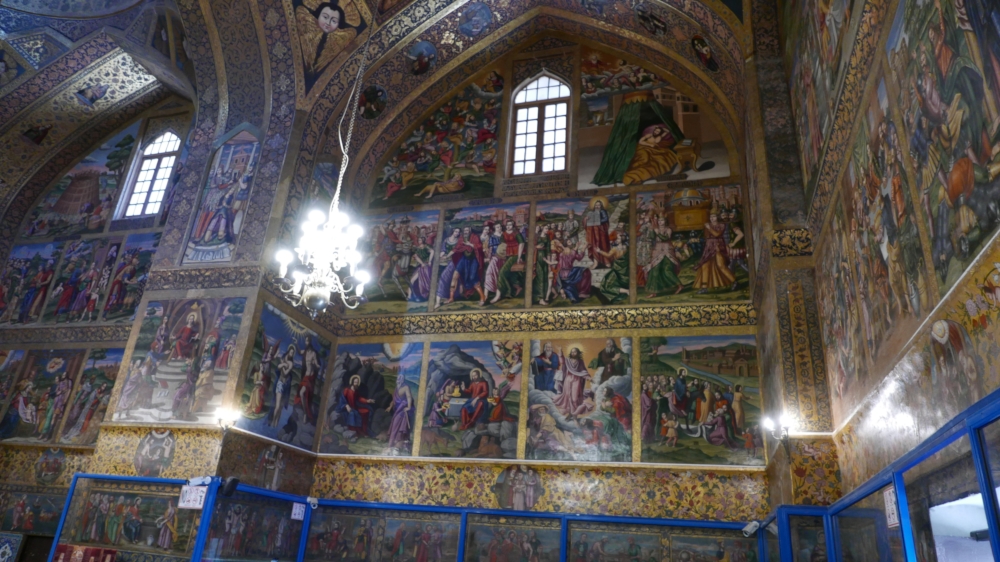
The inside of the Vank Cathedral
There are lots of pigeon towers in Iran. These buildings gave shelter to the pigeons - kept for their guano - against the vicissitudes of the weather and the snakes. It is worth to visit at least one of them. I suggest the Mardavij Pigeon Tower in Isfahan to visit.
Ghurtan and Varzaneh
I left Isfahan at half past six in the morning. Because of the early time I did not ask for breakfast. After the city I was riding on rural roads with low traffic volumes towards Ghurtan. The interestingness of these rural roads is that they are as wide as a 3-4 lane motorway with minimal traffic.
After about 20-30 km cycling I started looking for food. In a village I found a food shop, where I bought some cheese and drinks, but I couldn't buy any bred. (The Iranian „bred” is a big, pancake-like food, but it is much more thick and its English name is bered.) The salesman told me to go right to buy bered. It turned out that there is a bakery in the vicinity and they were baking bereds at that time. I asked for one. The workers were smiling and didn't allow me to pay for it.
I continued my journey when in Bersiyan a car driver began to speak Persian to me and pointed enthusiastically to the other side of the road. I felt that they would invite me to eat or drink with them, but I did not want to go to them without being invited. However the driver led me there, where locals made tea in a large cauldron. They greeted me as an old friend and offered a tea and some dates. Everybody was very kind, even also a little girl came to me and said hello. At first, I thought that it is only a local tradition. However, it was repeated three times over the next 50 kilometres. Namely, that day (Arbaeen) was the last of the 40-day long mourning period of the martyr’s death of Hussain ibn Ali (Ashura), who is the grandchild of Prophet Muhammad. It is one of the most important holy days in Iran. Finally, at my last stop I ran into the mass of pilgrims. Thousands of pilgrims, from top to toe in black clothes was coming towards me, while prayers came from huge loudspeakers of cars and SUVs. I have never got so many smiles in my life. Of course, this was not for me, but for the foreigner, for the other people. They stopped me and gave me to eat. Perhaps I was a little strange in my white jersey among the pilgrims dressed in black. This was my first pilgrimage, moreover here in central Iran. So I will have a basis for comparison, when I get to another pilgrimage.
My next stop was Ghurtan. The most important sight of the settlement is the citadel built in the 5th century, which is an imposing building complex of 5 hectares. There are, among others, three mosques, two castles and a bazar now in ruined conditions in the citadel.
I returned back to the main road, when two motor cyclists stopped me and pointed enthusiastically towards the inside of the citadel. I showed them the pictures made there to see I was already inside the complex. After a few hundred meters of cycling, the locals showed me to turn right. I did not understand the exact reason, but it is highly possible that they sent me in the direction where I found the best place to take pictures of the citadel. I was taking some pictures, when a guy came to me who works also as a travel guide and he briefly described the history of the castle. As it turned out he studies in Isfahan and on weekends he returns to his beautiful home village. This attachment to the homeland was very sympathetic to me, because I am also attached likewise to my beloved Bakony Mountains. I felt that here, five thousand kilometres from my mother country, people think about important and valuable things as we do. It is like I am at home. People are the same everywhere…
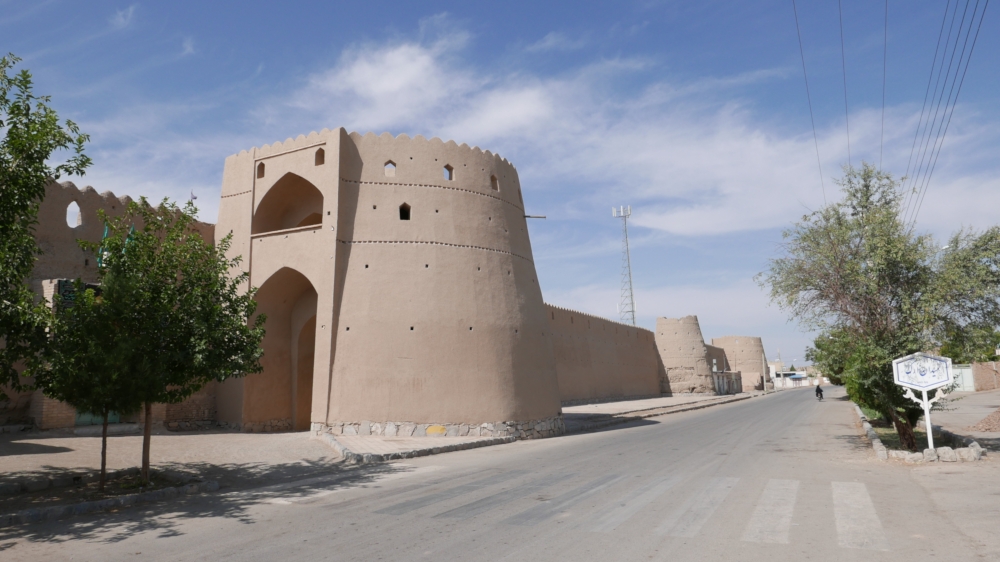
The citadel of Ghurtan
After the short guidance I continued my journey towards Varzaneh, which is the last settlement before the local desert. At first, I booked a room in the town, then ate a bowl of kebab in a nearby restaurant, finally I set off towards the desert. On the way, I even met a pack of 10-15 stray dogs. So I stood off to the side not provoking them, but they ignored me.
Firstly I visited the sand dunes, which are about 10 kilometres from the town, then I went further towards Hassan Abad.
On the way, in Dastjerd I would like to visit the Adineh Mosque, which stands hidden on the edge of the settlement. But I got an unexpected help from two 8-10-year-old children riding bikes. Dastjerd has a rural atmosphere, people was sitting in front of the houses and talking. This evening I was one of the most important „memorabilities” and topic of conversations. I was constantly feeling that I attracted the attention of locals. So I was smiling and greeting them continuously. Of course, my companions invited also their friends en route, so we made a relatively big group of bikers this evening. After looking at the mosque, felt embarrassed, so I cycled further in the wrong direction. Therefore, I had to go through the settlement three times…
After the adventure in Dastjerd I visited also the nearby old observatory, then continued my journey via Hassan Abad towards the Khara salt lake, which is now rather a salt desert. On the way to the desert I met a motor cyclist, who offered to drive me to the lake. Because already four persons were sitting on the motorbike, so I considered the offering as a joke. Maybe it was. Finally, I got only to halfway because the night was approaching and I did not want to subject my bike to further torture. Namely, the road between Hassan Abad and the salt lake is a real desert road, in some places covered with deep sand and I used a road bike. So I went back to my accommodation instead, and after the supper I went to bed relatively early.
Naein, Meybod, Yazd
On the following day I took some pictures of the Jameh Mosque, the local pigeon tower (Dovecote) and the historical bridge (Ostad Seyf). This section was also familiar to me because I had already cycled on this road. So I knew what the future held for me: long, slightly rising terrain over the next 35 kilometres.
After the town I was attacked by a dog, which came from a house next to the road. I was not cycling fast, I only paid attention not to decrease the distance between us. Fortunately a car appeared, which was going parallel to the dog. Not faster or slower. It seemed very much that the driver checked whether he should intervene for me or not.
The ascent is immediately followed by a steep slope after the crossing of the main road from Isfahan to Naein. Thanks to the long slope I quickly reached Naein. I have already been to this town, but at night. At this time, Naein showed me its other, entrancing face. I visited all of the important sights of the town: Jameh Mosque, Naryn castle, Imamzadeh Seyyed Ali Mosque, Mohammedia-Ashoorgah castle.
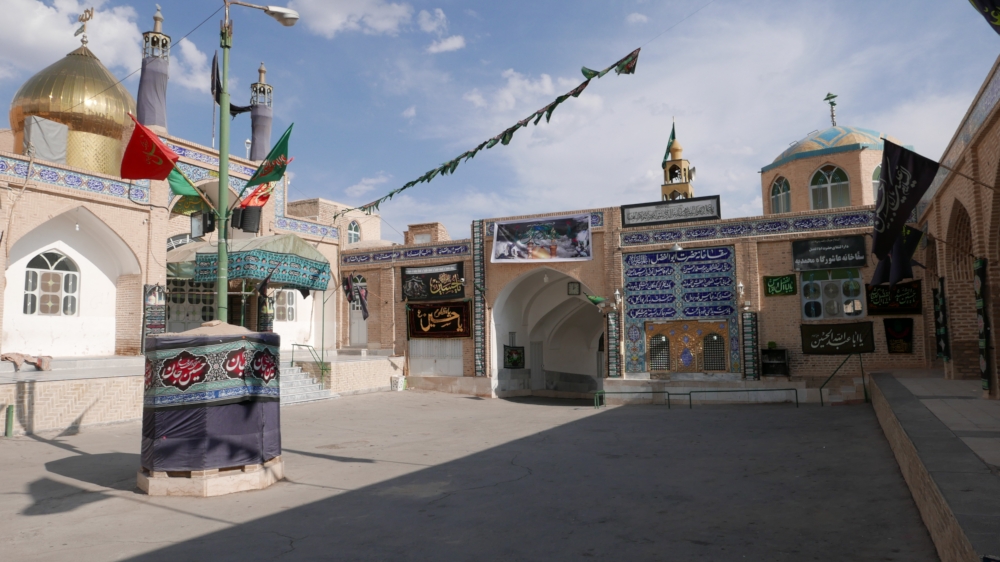
In Naein
Last year I slept in the guest house of the Imamzadeh Soltan Seyyed Ali Mosque. Since it was early, I continued my tour towards Yazd and did about 70 kilometres as far as Aqda, where I slept in a traditional guest house. Aqda is a real desert settlement with lots of fantastic buildings. The guest house also fits into this town structure.
My next day started almost immediately with a puncture, before Ardakan, at the 532th kilometre of my tour. It was a quite frustrating situation, because I had got a puncture almost here in 2018. I was afraid that my lucky chain of events were over. In my annoyance I had lost the hub nut of the quick release and the valve adapter. It needed longer time to find them, so the puncture repair was a big projekt for me.
There are also two castles in the next bigger settlement in Meybod. From these the Narin castle is far more famous. Here, in the foreground of the castle primary school girls were playing badminton, with whom I met later also in the castle. They found it very funny to meet a foreign cyclist. They kindly greeted me, though with a little bit of bantering style.
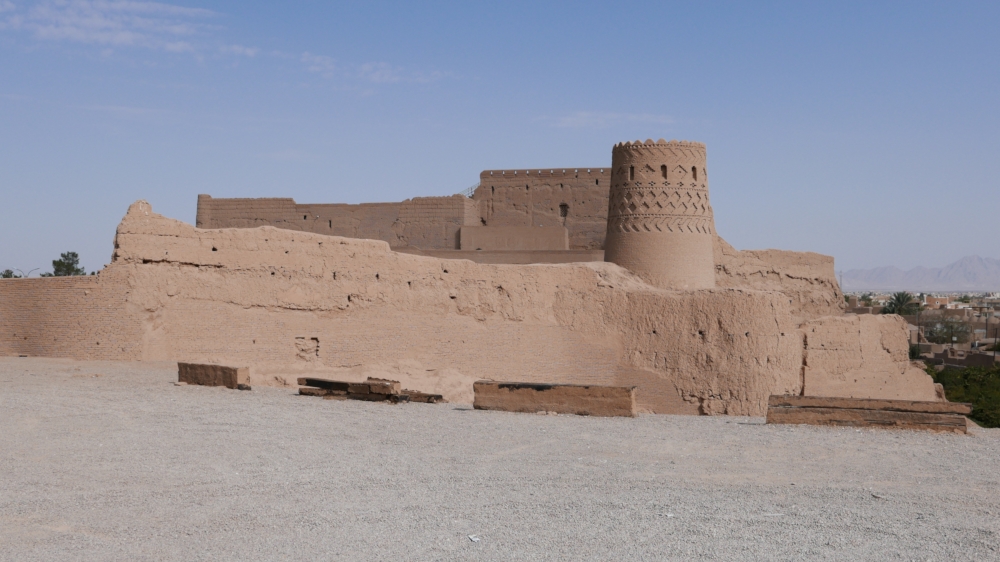
The Narin castle in Meybod
After it, I continued my journey towards Yazd. I had got high expectations for the city, since the old town is part of the world heritage list of UNESCO. I made a short detour to the wonderful Abrand castle, then visited the Dowlat Abad Garden. The latter one is a historical Persian garden and as such, it is also part of the world heritage list. Its further architectural significance is that the highest windcatcher of the country, which is 33.8 metres height to be found here. After visiting the garden, I booked a room in a traditional ecolodge of the old town. The landlady and the landlord were very kind. We were speaking using translation application and corrected the misunderstandings by smiling.
The old town of Yazd is a maze of alleyways with fantastic sights. It is quite difficult to find the way out from here without GPS. I visited the Alexander’s Prison and the Amir Chakhmaq Complex as well en route. The first-mentioned is in fact a mosque and a religious school. The origin of its name is debated. According to some opinions, the name refers to a poem by Hafez, others think that the building was built by Alexander the Great to imprison Persian rebels. And the Amir Chakhmaq Complex is one of the most important historical buildings of the town, which charms the visitors especially at night.
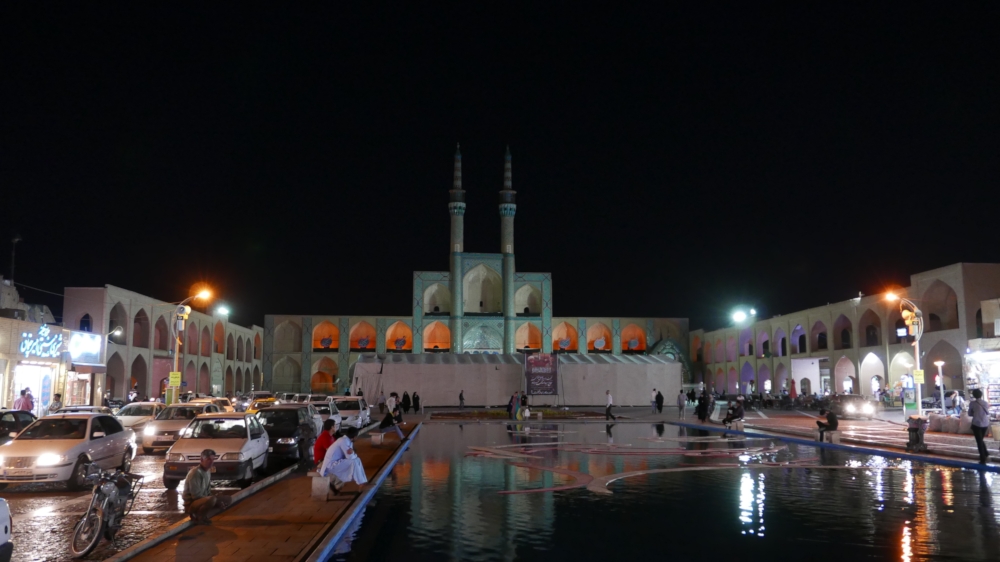
The Amir Chakhmaq Complex after sunset
Everything was traditional in the traditional bedroom of the traditional ecolodge. During the night, I protected myself against mosquitoes with mosquito net. I told to the host that the next day I had to depart early morning, so I did not need breakfast. But he started haggling with me to stay longer because I would get delicious breakfast tomorrow. Unfortunately I could not accept his request. Because of it they packed the breakfast. They was very generous and the parcel was too big, so it was difficult to put in my bag.
I visited also the Zoroastrian Towers of Silence in Yazd, which is a former burial ground and also an outstanding tourist attraction. Iran is the birthplace of the Zoroastrian religion that still exists today. According to its believers, the four elements (Fire, Water, Earth and Air) are holy, so they should not be polluted with corpses. Because of it, they entrusted the destruction of dead bodies to vultures. Unfortunately, it was bad tactics to left the accommodation early, so I had to wait almost an hour and a half for the opening time of the cemetery.
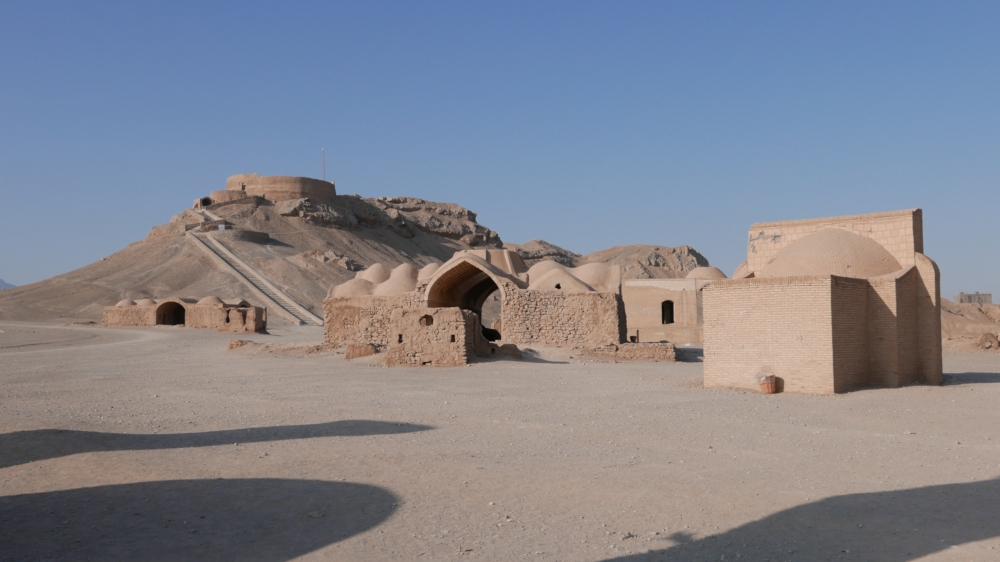
The Zoroastrian Towers of Silence on the outskirts of Yazd
Further on the way of world heritages
After Yazd I rode directly towards Shiraz, which, however was another three-day journey. My plan for the day was to get to Abarkuh, which meant a roughly 170 km long section. On the way, the road reaches 2600 metres. Although the ascent of this road is not strenuous, the landscape and the road have got a real high altitude atmosphere. I was almost on the top of the mountain when a lorry started driving directly in front of me and a man sitting next to the driver enthusiastically gesticulated to me. All I understood was that they wanted to help me to ride to the top of the mountain. But the method of help remained unknown to me. Should I cling to the lorry? Or do they only want me to use their slipstream? I thanked them for the offer, but refused it, because I wanted to get to the top of the mountain through my own efforts.
That day there was even a drizzling rain and stormy crosswind. There are only stunted bushes along the road without another object, so at the first bigger bush I almost rode into the ditch because of the unexpected windless conditions and the countersteering.
Abarkuh is a very nice settlement. A big brown tourist sign welcomes visitors to the town. Its most important sights are the citadel, the Gondab Ali, the Icehouse and the Cypress, which is more than 4,000 years old. The latter one is strictly protected. Because it was almost dark when I arrived to the town, so I looked for accommodation. I found a traditional guest house, which was, however, closed. I called the owner, who arrived shortly after, so I did not have to sleep under the starry sky.
On the following day I visited the listed attractions of the town and continued my journey towards Pasargadae. It was another nearly 170 km long section with the highest point more than 2500 metres above sea level again. On the way, two Iranian hippies stopped and offered to give me a lift. I did not take the opportunity, but it was very nice for me.
I bought some food and drink on the top of the mountain. The neighbouring shop’s owner, a young man invited me for tea. He told me that here, on the top of the mountain, the temperature was 13 degrees below zero last winter. After the common consternation I continued my journey towards Pasargadae. I was riding on not too steep but long slopes. With few exceptions, I was greeted with tooting horns from every car (and lorry) driver.
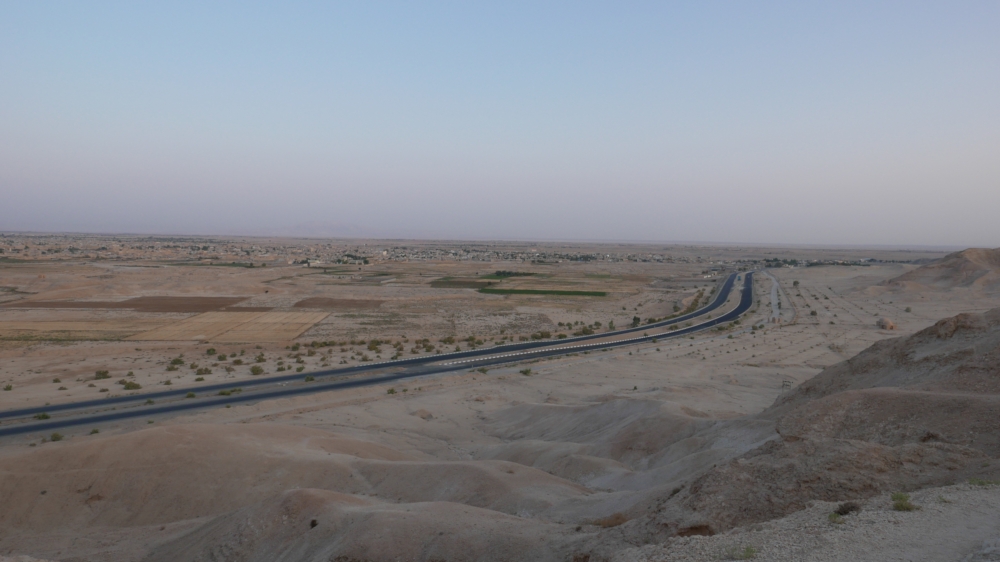
Desert landscape near Abarkuh
I got serious mental help for overcoming the distance from the brown tourist signs, which show the distances to Pasargadae, Naqsh-e Rostam and Persepolis. It was an awesome feeling to see the names of these ancient miracles on the signs. Undoubtedly, it was the main road of history in olden times.
In the next small town I ate lunch in a roadside inn, which is presumably the regular haunt of the local workers. Although, I was very hungry, but I still ordered too much food. Namely, because of communication difficulties I got two dishes of kebab. However, after some effort, I successfully ate most of it. I continued my journey towards Pasargadae, where I arrived before the desert sun had fallen below the horizon.
After turning off the main road, I found a police checkpoint. However, the policemen allowed me to ride further without control. I rode into the settlement and after some interest I booked a guest house near the World Heritage Site.
On the following day I got up early again. The temperature was only 8 degrees centigrade outside. Fortunately the air warmed quickly, so in less than an hour and a half the weather was pleasantly warm.
Pasargadae is an ancient ruined city, which was the first dynastic capital of the Achaemenid Empire founded by Cyrus II the Great in the 6th century BC. It was the first multicultural empire in Western Asia, spanning from the Eastern Mediterranean to the Indus River. The ruined city has got a lot of sights: the tomb of Cyrus II the Great, the Gate Palace, the Private Palace, the Solomon’s Prison etc. According to historians, the latter one’s name came from the time of Arab conquest, when Islamic names were given to buildings to prevent them from being destroyed by the conquerors. Although Pasargade is in much worse condition than Persepolis, but it was kinder to me. This is probably because it was the first ancient ruined city of my tour.
Pasargadae is located in a very large area, the distance between the two furthest points is more than 2.5 km. Fortunately I could ride on the roads of the archeological site, so I visited all of the sights quickly.
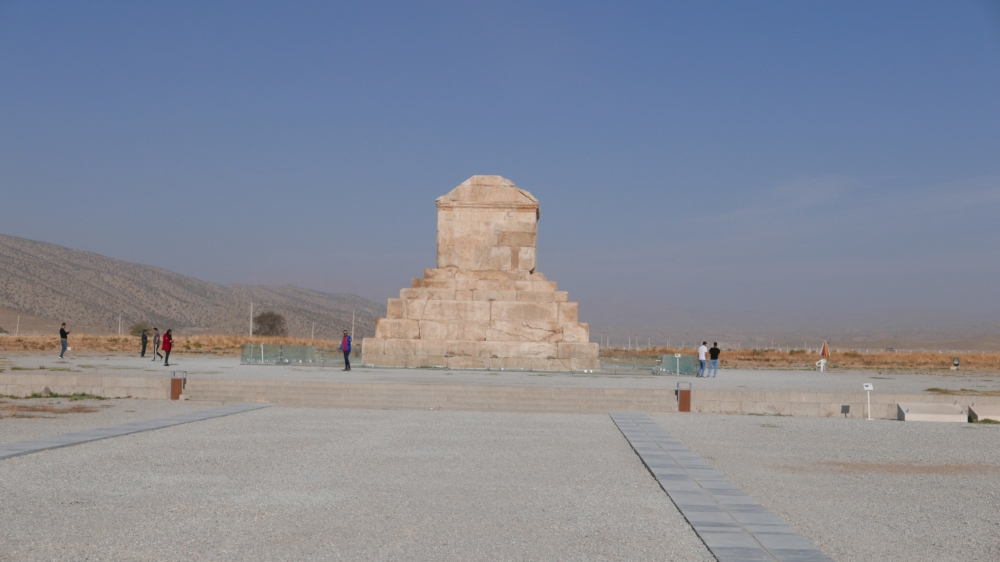
The most important sight of Pasargadae: The tomb of Cyrus II the Great
I continued my journey towards the Naqsh-e Rostam, which was the next outstanding tourist attraction. This 70 km long section was relatively uneventful. On the way I stopped to take a picture of a golden dome mosque, which was built before a steep rock face. A car driver shouted to me, when I returned to my bike after took some pictures: „My name is Ahmed.” I felt that he just wanted to say something kind to me and that was all what he could say in English. Of course, the intention is more important than the act…
Because of the lack of rainfall, animal husbandry plays an important role in the agriculture sector of Iran. In this section I met several shepherds. Perhaps they were the friendliest I had met on my tour. They waved very enthusiastically to me from the edge of the road. I became enthusiastic too and waved back.
Naqsh-e Rostam is an ancient necropolis from the Achaemenid and Sassanid periods, one of the most beautiful sights of Iran where four achaemenid kings (Darius I, Xerxes I, Artaxerxes I and Darius II) are buried in tombs cut into the rock. These are complemented by reliefs depicting the heroic feats of the Sassanid kings. However, according to researchers, the necropolis had existed long before that, namely in the period of Elamite kings.
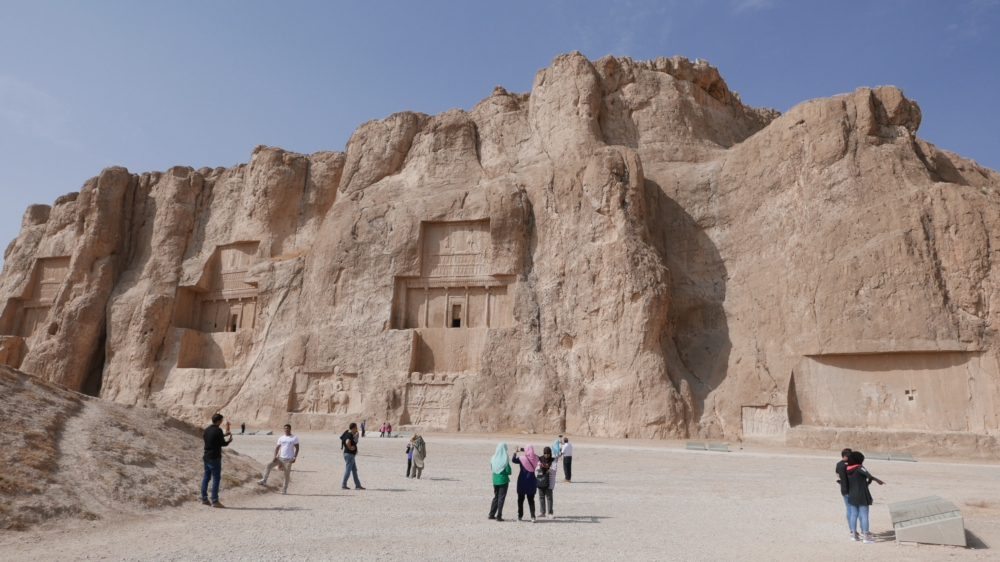
Naqsh-e Rostam
Not far from here is the much lesser-known Naqsh-e Rajab, where also rock reliefs evoke the glory of past ages. Although this site has no historical significance and without local knowledge it is not clear that we are looking for it in the right place, but still it is worth visiting. Accordingly, when I entered the fenced area, I was welcomed only by a dog. It squinted at me and continued lying. Fortunately the cashier turned up shortly afterwards, so I could make sure that I was in the right place.
Perhaps the most famous sight of Iran is Persepolis, which is only about 10 km from here. This site is also strictly protected. Persepolis became the capital of the empire in the time of Darius I. The palace complex even as ruins is still an impressive sight, which includes everything that once characterized the art of the Persian Empire.
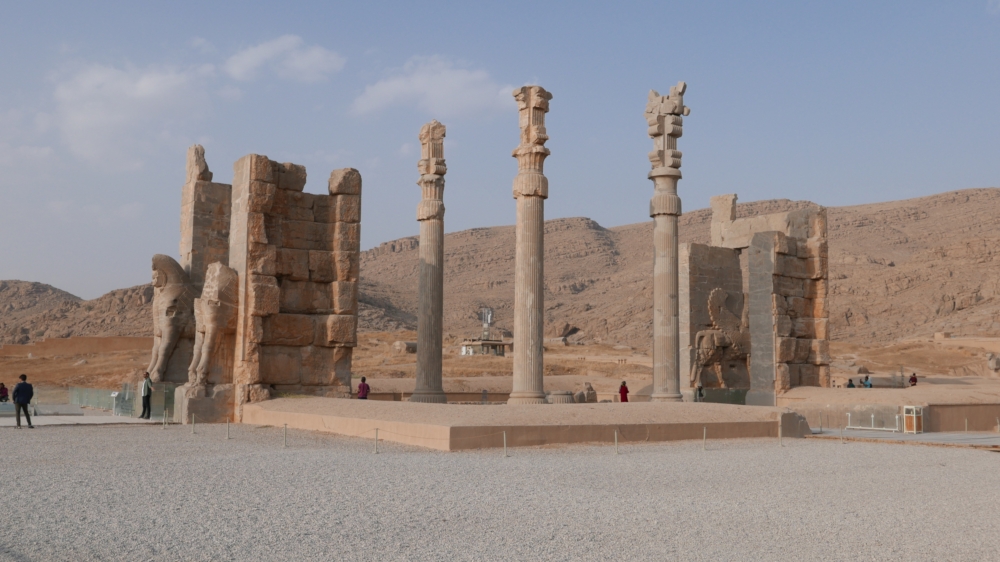
Persepolis
Persepolis was the only place in Iran where I heard Hungarian words. From an Irish guy. As it turned out he arrived by car in Persepolis and picked up some Hungarian phrases with almost perfect pronunciation in Budapest.
After Persepolis, I continued my tour towards Shiraz, which is only about 50 km from here. I had lost my hex key so I had to buy another one to remove the handlebar for transporting my bike by plane. Fortunately I found a toolmaker on the way to Shiraz. He did not accept money for the hex key, only asked for a common photo.
In this section, again the long but easy climbs was followed by steeper slopes. A motorcyclist joined me on the outskirts of Shiraz. The road descended here again, so I could ride easily at 40-45 km/h. We were riding next to each other and took up one whole lane of the highway…
Firstly I saw the Quran Gate when I arrived to Shiraz. At this time, in the evening it is even more spectacular than during the day. After it, I immediately looked for accommodation and found a cheap hotel in the historic downtown area.
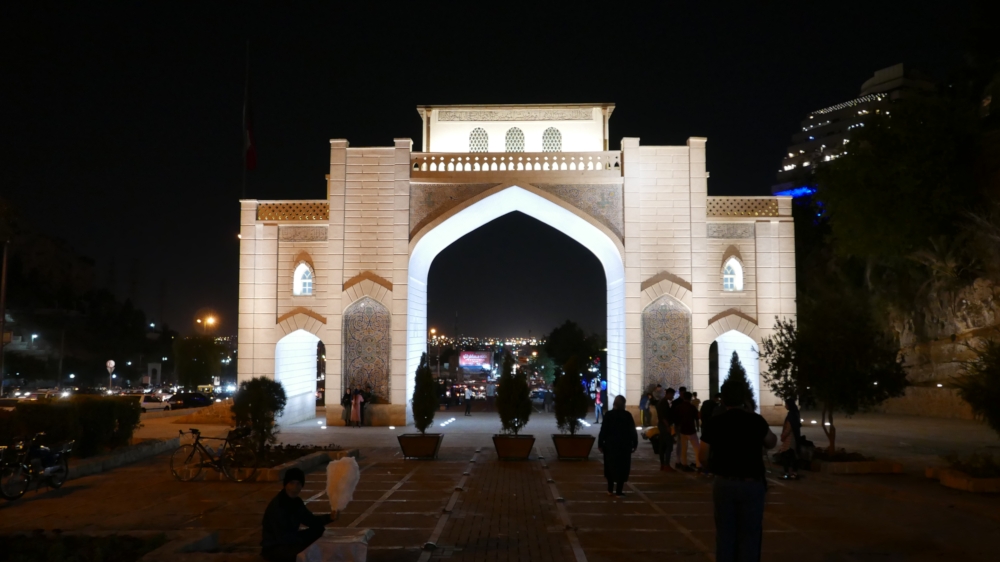
The Quran Gate at night
On the following day I got up early again. I saw a Cannondale road bike with a monoporter (unicycle bike trailer) in the passage, which is also used as a bicycle storage room. Shortly I met with the owner of the bike in the dining-room. We had a nice chat with each other. When I left the hotel, one of the hotel's staff members took a picture of me sitting on the bicycle saddle. After it, I continued my journey to explore the wonders of Shiraz.
Shiraz is one of the most beautiful towns of Iran. Among the most important sights, I visited the Nasir-Al-Mulk Mosque, the Eram Garden, the Tomb of Hafez and the Karim Khan Citadel. The Nasir-Al-Mulk is one of the most beautiful mosques in Iran. Its main attractions are the coloured windows of the eastern bedrooms, which create a fascinating, colourful world in the light of the sun. The Eram Garden is also an outstanding tourist attraction, which named after one of the gardens of the Quranic Paradise. Hafez is one of the most famous Iranian poets, who was born in Shiraz. His tomb is located in a marvellous garden, which is gladly visited by locals to pay their respects to the great poet.
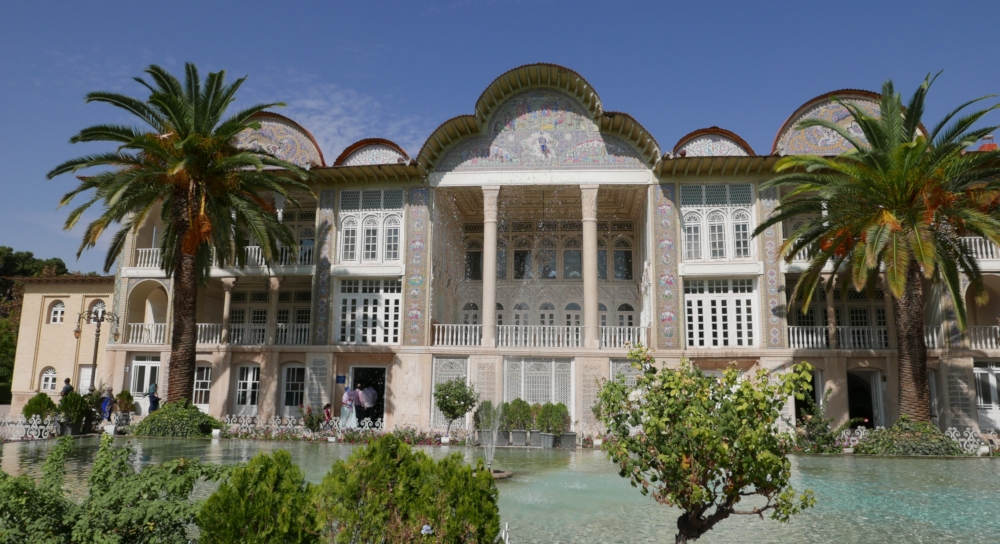
The Eram Garden
After visiting the sights of Shiraz, I went back to Isfahan by bus, where I arrived only after midnight. Nevertheless, I found a free room in the second hotel, what I visited. As it turned out I had already stayed in this hotel last year and the receptionist remembered me. I was very surprised to see that I found the same hotel though used another conception and route. It seems that in such a big city you can step in the same river twice.
On the following day I took a sightseeing tour again in Isfahan, bought cloth for the flight and travelled back to Tehran by bus. I rode to the airport from the bus terminal and flew home.
I rode 1,342 kilometres in total. Almost all of them has added something to my life, making it one of my most successful rides. In addition to the kindness of the locals and the sights, it also played an important role that I visited almost everything what I planned.
I hope to see my beloved Iran and Isfahan, the half of the world again as soon as possible.
My list of top 12 sights:
- Persepolis
- Naqsh-e Jahan Square
- Naqsh-e Rostam
- Nasir-Al-Mulk Mosque
- Eram Garden
- Amir Chakhmaq Complex
- Khaju Bridge
- Zoroastrian Towers of Silence
- Pasargadae
- Tomb of Hafez
- Narin castle
- Citadel of Ghurtan
The data of the tour:
Distance: 1,342 km
Total ascent: about 7,500 m
Number of days spent in Iran: 9
Punctures: 3
Number of visited UNESCO world heritages sites: 5
Number of welcoming toots: about 150
Number of smiles: about 1,200
Written by: Ákos Székely-Molnár



